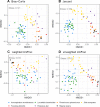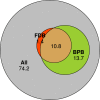Unveiled feather microcosm: feather microbiota of passerine birds is closely associated with host species identity and bacteriocin-producing bacteria
- PMID: 31127178
- PMCID: PMC6775979
- DOI: 10.1038/s41396-019-0438-4
Unveiled feather microcosm: feather microbiota of passerine birds is closely associated with host species identity and bacteriocin-producing bacteria
Abstract
The functional relevance of microbiota is a key aspect for understanding host-microbiota interactions. Mammalian skin harbours a complex consortium of beneficial microorganisms known to provide health and immune-boosting advantages. As yet, however, little is known about functional microbial communities on avian feathers, including their co-evolution with the host and factors determining feather microbiota (FM) diversity. Using 16S rRNA profiling, we investigated how host species identity, phylogeny and geographic origin determine FM in free-living passerine birds. Moreover, we estimated the relative abundance of bacteriocin-producing bacteria (BPB) and keratinolytic feather damaging bacteria (FDB) and evaluated the ability of BPB to affect FM diversity and relative abundance of FDB. Host species identity was associated with feather bacterial communities more strongly than host geographic origin. FM functional properties differed in terms of estimated BPB and FDB relative abundance, with both showing interspecific variation. FM diversity was negatively associated with BPB relative abundance across species, whereas BPB and FDB relative abundance was positively correlated. This study provides the first thorough evaluation of antimicrobial peptides-producing bacterial communities inhabiting the feather integument, including their likely potential to mediate niche-competition and to be associated with functional species-specific feather microbiota in avian hosts.
Conflict of interest statement
The authors declare that they have no conflict of interest.
Figures







Similar articles
-
Multi-level comparisons of cloacal, skin, feather and nest-associated microbiota suggest considerable influence of horizontal acquisition on the microbiota assembly of sympatric woodlarks and skylarks.Microbiome. 2017 Dec 1;5(1):156. doi: 10.1186/s40168-017-0371-6. Microbiome. 2017. PMID: 29191217 Free PMC article.
-
The evolution of size of the uropygial gland: mutualistic feather mites and uropygial secretion reduce bacterial loads of eggshells and hatching failures of European birds.J Evol Biol. 2012 Sep;25(9):1779-91. doi: 10.1111/j.1420-9101.2012.02561.x. Epub 2012 Jul 13. J Evol Biol. 2012. PMID: 22805098
-
Do feather-degrading bacteria actually degrade feather colour? No significant effects of plumage microbiome modifications on feather colouration in wild great tits.Naturwissenschaften. 2014 Nov;101(11):929-38. doi: 10.1007/s00114-014-1234-7. Epub 2014 Sep 17. Naturwissenschaften. 2014. PMID: 25228345
-
Medical Causes of Feather Damaging Behavior.Vet Clin North Am Exot Anim Pract. 2021 Jan;24(1):119-152. doi: 10.1016/j.cvex.2020.09.005. Vet Clin North Am Exot Anim Pract. 2021. PMID: 33189247 Review.
-
Feather mites (Acari: Astigmata): ecology, behavior, and evolution.Annu Rev Entomol. 2003;48:185-209. doi: 10.1146/annurev.ento.48.091801.112725. Epub 2001 Sep 28. Annu Rev Entomol. 2003. PMID: 12208818 Review.
Cited by
-
Body site microbiota of Magellanic and king penguins inhabiting the Strait of Magellan follow species-specific patterns.PeerJ. 2023 Nov 2;11:e16290. doi: 10.7717/peerj.16290. eCollection 2023. PeerJ. 2023. PMID: 37933257 Free PMC article.
-
An introduction to phylosymbiosis.Proc Biol Sci. 2020 Mar 11;287(1922):20192900. doi: 10.1098/rspb.2019.2900. Epub 2020 Mar 4. Proc Biol Sci. 2020. PMID: 32126958 Free PMC article.
-
Salt-induced recruitment of specific root-associated bacterial consortium capable of enhancing plant adaptability to salt stress.ISME J. 2021 Oct;15(10):2865-2882. doi: 10.1038/s41396-021-00974-2. Epub 2021 Apr 19. ISME J. 2021. PMID: 33875820 Free PMC article.
-
Protective role of native root-associated bacterial consortium against root-knot nematode infection in susceptible plants.Nat Commun. 2024 Aug 7;15(1):6723. doi: 10.1038/s41467-024-51073-7. Nat Commun. 2024. PMID: 39112511 Free PMC article.
-
Not so black, not so white: differences in microorganism load of contiguous feathers from white stork chicks.Curr Zool. 2020 Oct 16;67(3):263-270. doi: 10.1093/cz/zoaa062. eCollection 2021 Jun. Curr Zool. 2020. PMID: 34616918 Free PMC article.
References
-
- Fromont C, Riegler M, Cook JM. Relative abundance and strain diversity in the bacterial endosymbiont community of a sap-feeding insect across its native and introduced geographic range. Microb Ecol. 2017;74:722–34. - PubMed
-
- Kundu P, Blacher E, Elinav E, Pettersson S. Our gut microbiome: the evolving inner self. Cell. 2017;171:1481–93. - PubMed
Publication types
MeSH terms
Substances
LinkOut - more resources
Full Text Sources
Research Materials

